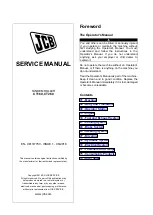
Section 2 - Crane Safety (Continued)
Telemotive Laser Guard Instruction Manual – October 2009
4
2-7.
Operating The Crane.
The crane anti-collision unit and limit switches if any
should be checked at the beginning of each shift or
when a new operator takes control of the crane.
When checking anti-collision unit and limit switches
the hoist should be centered over an area free of
personnel and equipment.
The anti-collision unit and limit switches should
never be used as a regular stopping device. They are
intended to be protective devices.
The bridge and trolley brakes should be tested at the
beginning of each shift or when a new operator takes
control of the crane. On cranes so equipped with two
or more speeds, use the "lowest" speed when testing
braking devices.
When lifting maximum loads, the crane operator
should test the hoist brakes by raising the load a few
inches from the floor. If the brakes do not hold, the
load should immediately be lowered to the floor and
a report made to the supervisor.
Do not make lifts in excess of the equipment rated
capacity.
The bridge and trolley should be centered directly
over the load when the load is raised to prevent
swinging when making lifts.
Side pulls should be made by a crane designed for
this purpose and only with supervisor permission.
When a lift is being made, the crane operator should
not be positioned in the line of travel. The crane or
hoist should be operated from a position either to the
side or opposite from the direction of travel.
When raising or lowering a load, proceed slowly and
make certain the load is under control. Tag lines
should be used for handling unusual lengths or bulky
loads. Remove slack from chains or slings gradually.
Make certain all personnel are clear before making a
lift.
The crane operator should keep all body parts away
from the lift and should never be positioned under the
lift.
Do not make a lift or move a load if anyone is in a
location where they could be struck by the crane or
the load.
If the crane operator is being helped, the crane should
not be moved until the helper signals they are clear of
the crane and its load.
When a load is hanging from the crane hook and the
crane is being moved, the crane operator should
sound all warning devices frequently.
Loads should not be carried over workers heads. If a
worker is in the path of crane travel, the crane
operator should stop the crane and clear the area
before proceeding.
Runway stops or other cranes should never be
bumped into.
When moving the crane, the crane operator should be
sure that the hook block and attachments or cables
would not catch on nearby equipment. Slings, chains,
or cables should never be dragged along the floor.
Unless required for operator safety, gloves should not
be worn when operating the transmitter unit.
All loose materials or parts should be removed from
the load before starting the lift.
The crane operator should always hoist lifts high
enough to clear all equipment and workers.
The crane operator should never permit anyone to
ride on the load or hook except when authorized by
the supervisor.
When another crane on the same runway is stationary
with a load hanging, the crane operator should
maintain a safe distance between the stationary crane
and the one under their control.
If power to the crane is removed, the crane operator
should turn the transmitter unit OFF and keep it OFF
until power is restored.
If the crane fails to respond properly, the crane
operator should stop operation, turn the transmitter
unit OFF and immediately report the condition to
their supervisor.
Outdoor cranes, which are subject to movement by
wind, should be securely anchored when left
unattended. If the crane is equipped with bridge
brakes, the parking brake should be set immediately.









































